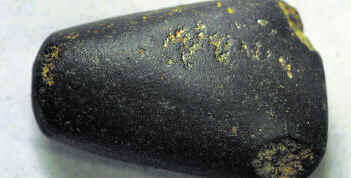A proposed Indus sign reading of Muruku on a stone axe found in South India.. This article was published in May 2006.
 There are two near-identical signs in the Indus Script (Nos. 47 & 48, I. Mahadevan 1977) depicting a seated god identified as muruku for reasons summarised in this Note. (For background details, see my 1999 paper Murukan In The Indus Script).
There are two near-identical signs in the Indus Script (Nos. 47 & 48, I. Mahadevan 1977) depicting a seated god identified as muruku for reasons summarised in this Note. (For background details, see my 1999 paper Murukan In The Indus Script).
A deity in the Indus script is likely to be an ideogram with a recognizable anthropomorphic form. The sign will also be of frequent occurrence and occur in repetitive passages suggesting some religious formula. Signs 47 and 48 representing a seated human-like figure meet the requirements and are identified as prima facie representing a popular Harappan deity.

The deity is represented as a skeletal body with a prominent row of ribs (in sign 48 only) and is shown seated on his haunches, body bent and contracted, with lower limbs folded and knees drawn up. The two related but distinct signs of the Indus script seem to have later coalesced into one symbol (resembling sign 47) outside the Harappan region. (For pictorial parallels from later times, see illustrations in I. Mahadevan 1999).
According to the interpretation proposed here, the seated posture is suggestive of divinity and the skeletal body gives the linguistic clue to the name of the deity. The basic Dravidian word mur (Ta. muri, Ka. muruhu, Pa. & Ga. murg, Go. moorga etc., DEDR. 4977) means 'to bend, contract, fold' etc. Applying the technique of rebus, we get mur (Ta. murunku, murukku; Ma.murukka, Kol., Nk. murk, Malt. murke etc., DEDR 4975) meaning 'to destroy, kill, cut'. etc. Thus the name of the deity muruku and his characteristics 'destroyer, killer' are derived.
The skeletal forms in the pictograms suggest that the god was conceived as a disembodied spirit.
Turning to the oldest layer of Tamil Sangam literature, We find that muruku/ murukan was a spirit who manifested himself only by possessing his priest (velan) or young maidens. The priest performed the veri dance to pacify the spirit. The earliest references to muruku in Old Tamil portray him as a 'wrathful killer' indicating his prowess as a war god and hunter (P.L. Samy 1990). Another important clue is the frequent association of the muruku and the load-bearer signs in the Indus Texts, paralleled by the association of murukan with kavadi in the Tamil society. Outside the Indus valley, the muruku symbol has been found on a seal from Vaisali, Bihar, dating probably from ca. 1100 BCE. (for details and previous references, see. I. Mahadevan 1999).
In Tamil Nadu, the muruku symbol was first identified from the pottery graffiti at Sanur, a megalithic site. B.B. Lal (1960) correctly identified this symbol with sign 47 of the Indus script. In recent years the muruku symbol has turned up among pottery graffiti found at Mangudi (TN Dept. of Archaeology, 2003) and at Muciri, Kerala (V. Selvakumar et al, in press).
All these occurrences on pottery belong to the Late Megalithic-Iron Age period overlapping with Early Historic Period (broadly, ca. 3cent. BCE-3 cent. CE). It is likely that the symbol retained the same meaning and sound value as at Harappa, though it occurs only as an isolated symbol on Megalithic pottery and not part of a script. 2
However, the latest discovery of an Indus Text with four signs engraved on a Neolithic polished stone celt (ca. 2000-1000 BCE) from Tamil Nadu is a revolutionary advance with far-reaching implications. Unlike the megalithic graffiti, the text on the Neolithic tool is in the classical Indus script characters. The first and the second signs (signs 48 and signs 342), namely muruku and the 'jar' (to be read as -an) also form a well-known and very frequent combination on the Indus seals and sealings especially from Harappa. The third and fourth signs also occur in the Indus script (signs 367 & signs301), but their value is not yet known.
We can therefore conclude that the Harappans and the Neolithic people of Tamil country spoke the same language, namely Dravidian. It is recorded that the Neolithic people of South India were in contact with the Late Harappan or post -Harappan people of the Deccan. It is known that gold for the ornaments found at Mohenjodaro came from the Kolar gold fields in Karnataka. Finally, reference can be made to the traditional accounts in old Tamil literature tracing the origin of the Velir cheiftains to migration from the Saurashtra region of Gujarat which was at that time part of the Harappan civilization.
It is emphasised that the occurrence of the Indus text on the Neolithic tool and the consequences flowing therefrom are independent of the tentative phonetic values and meanings proposed by me.
![]() muruk(u)- an- (?)- (?) proposed reading of the text on the Neolithic celt.
muruk(u)- an- (?)- (?) proposed reading of the text on the Neolithic celt.
Photograph of stone celt courtesy The Hindu.
References
1. DEDR: Dravidian Etymological Dictionary -Revised, Burrow and Emeneau, Oxford, 1984.
2. Excavations at Mangudi, 2003. Department of Archaeology, Tamil Nadu.
3. B.B. Lal, 1960. From "Megalithic to the Harappa: Tracing back the graffiti on pottery." Ancient India, No.16, pp.4-24.
4. Iravatham Mahadevan 1977. The Indus Script: Texts, Concordance and Tables. Archaeological Survey of India, New Delhi.
5. Iravatham Mahadevan 1999. "Murukan in the Indus script." Journal of the Institute of Asian Studies
Vol. XVI, No.2, 1999, pp.21-39.
6. Iravatham Mahadevan 2001. The Indus- like symbols on Megalithic Pottery. Vidyarnavavandanam, Essays in honour of Asko Parpola, pp. 379-386, Helsinki.
7. P.L. Samy,1990. Sanga nulkalil Murukan. Madras.
8. V. Selvakumar, et. al. Pottery inscriptions and graffiti from Pattanam (Muciri), Kerala. International Journal of Dravidian Linguistics (forthcoming).

